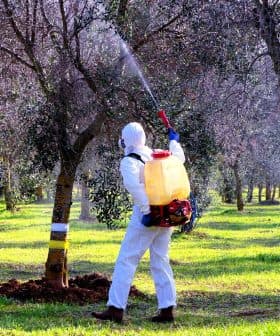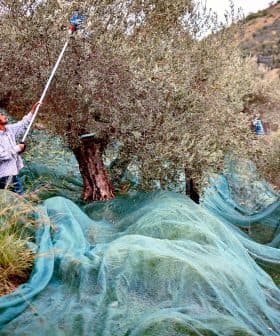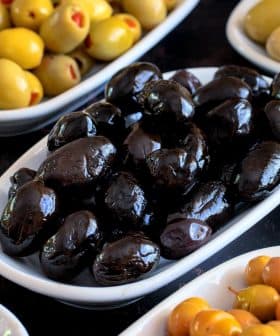Climate Disasters Drive Prices Higher
Drought on the Iberian Peninsula and floods in Croatia have resulted in a rocky start to olive development, spurring more price rises.
 A man wades through flooding waters in Obrovac, Croatia, Tuesday, May 16, 2023. (AP Photo)
A man wades through flooding waters in Obrovac, Croatia, Tuesday, May 16, 2023. (AP Photo) Olive oil prices in southern Europe are rising due to ongoing climatic disasters, with Spain experiencing a 55 percent decrease in production leading to higher prices. The drought and high temperatures are expected to continue, affecting olive oil production and prices in other international markets as well.
As much of southern Europe endures scorching temperatures and flash flooding, olive oil prices in the main benchmark markets continue to rise.
Italian extra virgin olive oil has nearly reached the price of €7 per kilogram. Greek oil has exceeded €6 per kilogram, and Spanish oils are approaching the same price.
The main culprit for the rise in prices is ongoing climatic disasters. Due to droughts and enormously high temperatures in the 2021/22 crop year, olive oil production in Spain fell by 55 percent year-on-year to 660,000 tons.
See Also:Global Olive Oil Production Predicted to ReboundDrastically lower yields in the country, usually responsible for almost half of global production and annual exports of nearly €3 billion, have resulted in rising prices across the olive oil sector supply chain.
Due to its immense size, prices in Spain largely dictate prices in other international markets.
“Compared with €5,300 per ton in January this year, the wholesale price in mid-April was €5,800 per ton,” said Fanny de Gasquet of Baillon Intercor, a brokerage specializing in oils and fats. In January 2022, one ton of olive oil sold for €3,500.
Analysts expect prices to continue rising with the drought continuing unbroken across large swaths of southern Europe.
“It has hardly rained since January this year, so the land is very dry,” said Cristobal Cano, secretary general of the Union of Small Farmers in Andalusia, the center of Spain’s olive oil industry.
Cano, who owns ten hectares of olive trees near Granada, added that he has never experienced such worrying conditions in the 20 years he has been farming. “If something radical doesn’t change in the next few weeks, disaster will follow,” he said.
Fear and concern are understandable. According to data from the Spanish meteorological agency, Aemet, since October 1, 2022, Spain has received 25 percent less precipitation than usual. Andalusia has received 50 percent less, and reservoir capacity is only 25 percent.
Compounding the problems created by the drought, Spain was hit by an early heat wave at the end of April. In the south of the country, the mercury rose to 38.8 ºC right at the time of olive blossoming.
“Without flowers, there are no fruits. And if there are no fruits, there will be no oil,” said Rafael Pico Lapounete, the executive director of the Spanish Association of Olive Oil Exporters, Industry and Commerce (Asoliva).
A similar problem worries Portuguese olive growers. Production in the country’s 150,000 hectares of super-high-density (super-intensive) olive groves may be threatened due to the drought, with a lack of water in the soil and irrigation basins.
However, the situation is better in Italy. Local media reports indicate that olive growers expect a better year, especially in the country’s south, home to the most productive olive-growing regions.
Given the suitable climatic conditions, which have continued into the spring, Italian olive growers hope there will be no sudden warming during the flowering phase. Good flowering and fertilization are the main preconditions for the return of Italian production to above 300,000 tons.
Still, this would be too little to compensate for the deficit created by poor harvests in Spain and Portugal.
The result: a new jump in olive oil prices across the Mediterranean basin. They are already very close to the recently-unimaginable €7 per kilogram, and even that limit could be exceeded by the end of May.
High prices affect producers and consumers, who increasingly turn to other cooking oils. Bottlers across the Mediterranean prefer stockpiling to ensure minimum commercial stocks for the next season.
The Spanish government reduced the value-added tax on olive oil from 10 to 5 percent at the end of 2022 as part of a package of measures to help consumers cope with rising inflation. To help farmers manage the drought. The government also reduced the income tax in this sector by 25 percent.
But what no single government can influence is climate change, which has led to all these problems. As a result, all the countries of the Mediterranean basin are faced with the consequences, temperature and weather extremes.
There are droughts and fires in Spain, Portugal and France; there are floods in Croatia, especially in northern Dalmatia.
“For the inhabitants of the Mediterranean basin, this is alarming. In addition to the region being extremely sensitive to climate change, it also has one of the fastest rates of urbanization in the world,” said Erdal Sabri Ergen, the deputy general secretary of the Union for the Mediterranean (UfM) in charge of transport and urban development.
The Mediterranean Sea and its coasts are warming 20 percent faster than the world average, so it is the second most threatened area after the Arctic, added Ergen on the eve of the third UfM ministerial conference in Zagreb, the capital of Croatia.
In the meantime, an unprecedented amount of precipitation has fallen in Croatia. As a result, fourteen rivers have overflowed their banks, endangering towns and villages. Thousands of hectares of agricultural land were flooded, paralyzing all agricultural activity. Some olive groves even appear to be growing in lakes.
“The ground can no longer absorb water because it is completely saturated with moisture, and the rain that has been falling for the last two or three days mostly runs off the surface,” said meteorologist Krunoslav Mikec, head of the Croatian Hydrometeorological Institute.
Once again, none of the countries in the western Mediterranean basin will be spared from the impacts of climate change.
Even though the problem will not simply resolve itself, global world leaders have not yet begun to coordinate their actions to find a solution to stem the flow of greenhouse gas emissions and prevent average global temperatures from exceeding pre-industrial levels by 1.5 ºC.
Share this article









